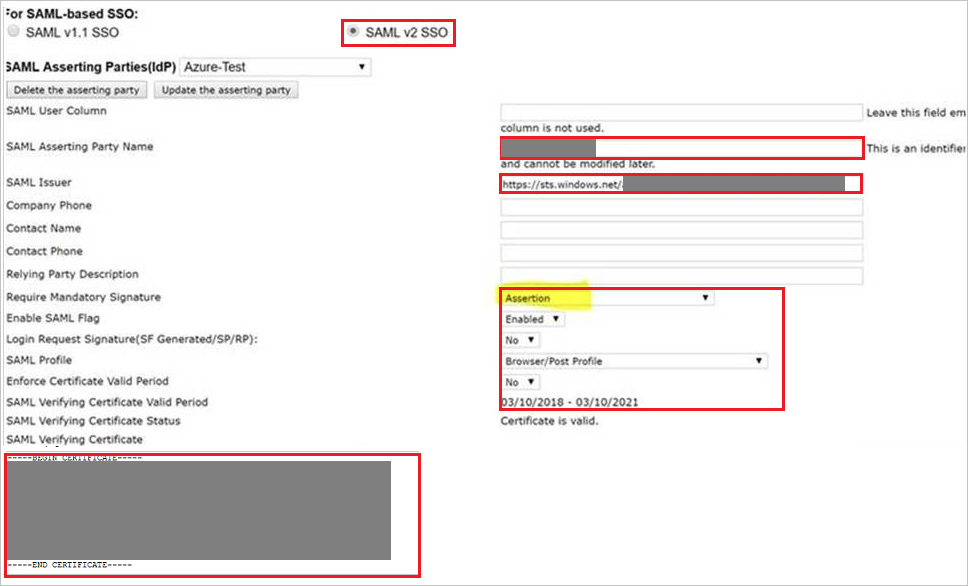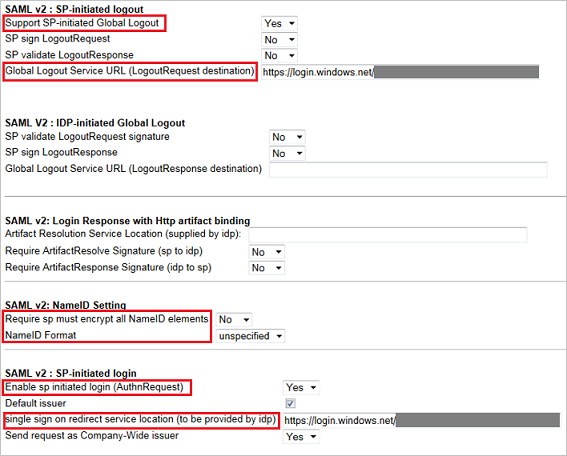Microsoft Entra single sign-on (SSO) integration with SuccessFactors
In this article, you'll learn how to integrate SuccessFactors with Microsoft Entra ID. When you integrate SuccessFactors with Microsoft Entra ID, you can:
- Control in Microsoft Entra ID who has access to SuccessFactors.
- Enable your users to be automatically signed-in to SuccessFactors with their Microsoft Entra accounts.
- Manage your accounts in one central location.
Prerequisites
To get started, you need the following items:
- A Microsoft Entra subscription. If you don't have a subscription, you can get a free account.
- SuccessFactors single sign-on (SSO) enabled subscription.
Scenario description
In this article, you configure and test Microsoft Entra SSO in a test environment.
- SuccessFactors supports SP initiated SSO.
Adding SuccessFactors from the gallery
To configure the integration of SuccessFactors into Microsoft Entra ID, you need to add SuccessFactors from the gallery to your list of managed SaaS apps.
- Sign in to the Microsoft Entra admin center as at least a Cloud Application Administrator.
- Browse to Identity > Applications > Enterprise applications > New application.
- In the Add from the gallery section, type SuccessFactors in the search box.
- Select SuccessFactors from results panel and then add the app. Wait a few seconds while the app is added to your tenant.
Alternatively, you can also use the Enterprise App Configuration Wizard. In this wizard, you can add an application to your tenant, add users/groups to the app, assign roles, as well as walk through the SSO configuration as well. Learn more about Microsoft 365 wizards.
Configure and test Microsoft Entra SSO for SuccessFactors
Configure and test Microsoft Entra SSO with SuccessFactors using a test user called B.Simon. For SSO to work, you need to establish a link relationship between a Microsoft Entra user and the related user in SuccessFactors.
To configure and test Microsoft Entra SSO with SuccessFactors, perform the following steps:
- Configure Microsoft Entra SSO - to enable your users to use this feature.
- Create a Microsoft Entra test user - to test Microsoft Entra single sign-on with B.Simon.
- Assign the Microsoft Entra test user - to enable B.Simon to use Microsoft Entra single sign-on.
- Configure SuccessFactors SSO - to configure the Single Sign-On settings on application side.
- Create SuccessFactors test user - to have a counterpart of B.Simon in SuccessFactors that is linked to the Microsoft Entra representation of user.
- Test SSO - to verify whether the configuration works.
Configure Microsoft Entra SSO
Follow these steps to enable Microsoft Entra SSO.
Sign in to the Microsoft Entra admin center as at least a Cloud Application Administrator.
Browse to Identity > Applications > Enterprise applications > SuccessFactors application integration page, find the Manage section and select Single sign-on.
On the Select a Single sign-on method page, select SAML.
On the Set up Single Sign-On with SAML page, click the pencil icon for Basic SAML Configuration to edit the settings.

On the Basic SAML Configuration section, perform the following steps:
a. In the Sign-on URL textbox, type a URL using one of the following patterns:
https://<companyname>.successfactors.com/<companyname>https://<companyname>.sapsf.com/<companyname>https://<companyname>.successfactors.eu/<companyname>https://<companyname>.sapsf.eu
b. In the Identifier textbox, type a URL using one of the following patterns:
https://www.successfactors.com/<companyname>https://www.successfactors.comhttps://<companyname>.successfactors.euhttps://www.successfactors.eu/<companyname>https://<companyname>.sapsf.comhttps://hcm4preview.sapsf.com/<companyname>https://<companyname>.sapsf.euhttps://www.successfactors.cnhttps://www.successfactors.cn/<companyname>
c. In the Reply URL textbox, type a URL using one of the following patterns:
https://<companyname>.successfactors.com/<companyname>https://<companyname>.successfactors.comhttps://<companyname>.sapsf.com/<companyname>https://<companyname>.sapsf.comhttps://<companyname>.successfactors.eu/<companyname>https://<companyname>.successfactors.euhttps://<companyname>.sapsf.euhttps://<companyname>.sapsf.eu/<companyname>https://<companyname>.sapsf.cnhttps://<companyname>.sapsf.cn/<companyname>
Note
These values are not real. Update these values with the actual Sign-on URL, Identifier and Reply URL. Contact SuccessFactors Client support team to get these values.
On the Set up Single Sign-On with SAML page, in the SAML Signing Certificate section, find Certificate (Base64) and select Download to download the certificate and save it on your computer.

On the Set up SuccessFactors section, copy the appropriate URL(s) based on your requirement.

Create a Microsoft Entra test user
In this section, you'll create a test user called B.Simon.
- Sign in to the Microsoft Entra admin center as at least a User Administrator.
- Browse to Identity > Users > All users.
- Select New user > Create new user, at the top of the screen.
- In the User properties, follow these steps:
- In the Display name field, enter
B.Simon. - In the User principal name field, enter the username@companydomain.extension. For example,
B.Simon@contoso.com. - Select the Show password check box, and then write down the value that's displayed in the Password box.
- Select Review + create.
- In the Display name field, enter
- Select Create.
Assign the Microsoft Entra test user
In this section, you'll enable B.Simon to use single sign-on by granting access to SuccessFactors.
- Sign in to the Microsoft Entra admin center as at least a Cloud Application Administrator.
- Browse to Identity > Applications > Enterprise applications > SuccessFactors.
- In the app's overview page, select Users and groups.
- Select Add user/group, then select Users and groups in the Add Assignment dialog.
- In the Users and groups dialog, select B.Simon from the Users list, then click the Select button at the bottom of the screen.
- If you are expecting a role to be assigned to the users, you can select it from the Select a role dropdown. If no role has been set up for this app, you see "Default Access" role selected.
- In the Add Assignment dialog, click the Assign button.
Configure SuccessFactors SSO
In a different web browser window, log in to your SuccessFactors admin portal as an administrator.
Visit Application Security and native to Single Sign On Feature.
Place any value in the Reset Token and click Save Token to enable SAML SSO.

Note
This value is used as the on/off switch. If any value is saved, the SAML SSO is ON. If a blank value is saved the SAML SSO is OFF.
Native to below screenshot and perform the following actions:

a. Select the SAML v2 SSO Radio Button
b. Set the SAML Asserting Party Name(for example, SAML issuer + company name).
c. In the Issuer URL textbox, paste the Microsoft Entra Identifier value which you copied previously.
d. Select Assertion as Require Mandatory Signature.
e. Select Enabled as Enable SAML Flag.
f. Select No as Login Request Signature(SF Generated/SP/RP).
g. Select Browser/Post Profile as SAML Profile.
h. Select No as Enforce Certificate Valid Period.
i. Copy the content of the downloaded certificate file from Azure portal, and then paste it into the SAML Verifying Certificate textbox.
Note
The certificate content must have begin certificate and end certificate tags.
Navigate to SAML V2, and then perform the following steps:

a. Select Yes as Support SP-initiated Global Logout.
b. In the Global Logout Service URL (LogoutRequest destination) textbox, paste the Sign-Out URL value which you have copied form the Azure portal.
c. Select No as Require sp must encrypt all NameID element.
d. Select unspecified as NameID Format.
e. Select Yes as Enable sp initiated login (AuthnRequest).
f. In the Send request as Company-Wide issuer textbox, paste Login URL value which you copied previously.
Perform these steps if you want to make the login usernames Case Insensitive.

a. Visit Company Settings(near the bottom).
b. Select checkbox near Enable Non-Case-Sensitive Username.
c. Click Save.
Note
If you try to enable this, the system checks if it creates a duplicate SAML login name. For example if the customer has usernames User1 and user1. Taking away case sensitivity makes these duplicates. The system gives you an error message and does not enable the feature. The customer needs to change one of the usernames so it’s spelled different.
Create SuccessFactors test user
To enable Microsoft Entra users to sign in to SuccessFactors, they must be provisioned into SuccessFactors. In the case of SuccessFactors, provisioning is a manual task.
To get users created in SuccessFactors, you need to contact the SuccessFactors support team.
Test SSO
In this section, you test your Microsoft Entra single sign-on configuration with following options.
Click on Test this application, this will redirect to SuccessFactors Sign-on URL where you can initiate the login flow.
Go to SuccessFactors Sign-on URL directly and initiate the login flow from there.
You can use Microsoft My Apps. When you click the SuccessFactors tile in the My Apps, this will redirect to SuccessFactors Sign-on URL. For more information about the My Apps, see Introduction to the My Apps.
Related content
Once you configure the SuccessFactors you can enforce session controls, which protects exfiltration and infiltration of your organization’s sensitive data in real time. Session controls extends from Conditional Access. Learn how to enforce session control with Microsoft Defender for Cloud Apps.